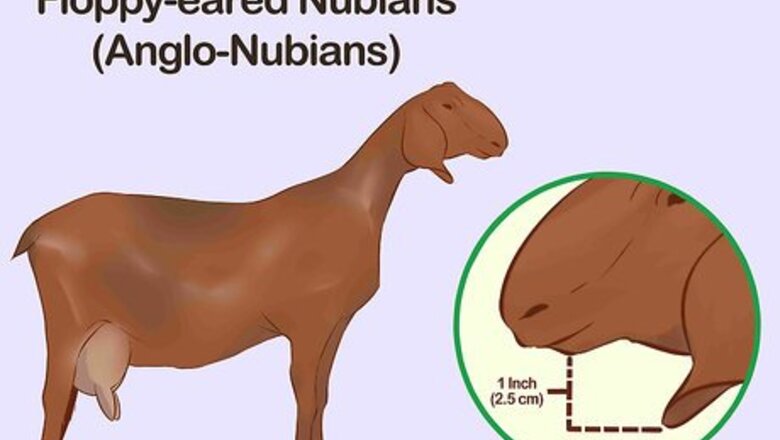
views
Looking for Common Breeds' Features
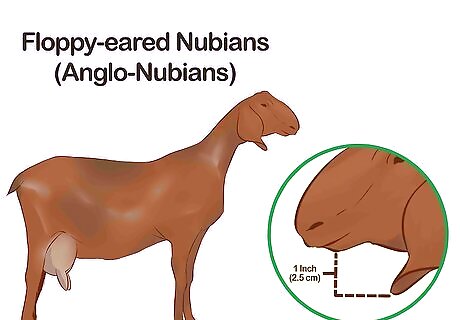
Look for floppy-eared Nubians. If your goat has floppy ears that hang about 1 inch (2.5 cm) below its muzzle, you can be sure it’s a Nubian. Also known as Anglo-Nubians, this is a common breed of goat across the world. They are typically stubborn, have round muzzles, and their short, fine coats come in a variety of colors and patterns. Nubians are considered both dairy and meat goats. They don’t produce as much milk as other breeds, but they’re a popular dairy goat due to their milk’s rich fat content. In addition, they usually do better in warmer climates than other dairy goats, such as Swiss breeds.
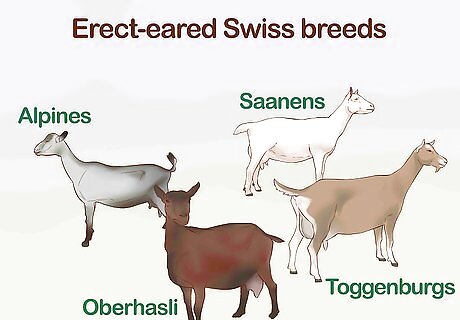
Distinguish between docile, erect-eared Swiss breeds. Used for dairy production, Swiss breeds have straight faces, ears that point straight up, are generally calm, and almost always have a tall build. A Swiss breed doe, like does of any other dairy breed, should have a plump, well-formed udder. Common Swiss breeds include: Alpines, which come in a variety of color patterns, are considered the top-producing dairy goat. They’re a tall breed; does stand at least 32.5 inches (83 cm) at the shoulder, and bucks stand at least 37 inches (94 cm). The Oberhasli has a distinct light to deep red coat with black markings on the belly, legs, and face. With a tall, rugged frame, Saanens are built like Alpines, but are always white or cream. They’re a top milk-producing breed and, since they’re extremely docile, they’re well-suited to machine milking. Toggenburgs are usually shorter than other dairy breeds, but are robustly built. They also tend to be more active and alert than other dairy breeds. Their coats range from deep to light brown with various patches of white or cream.
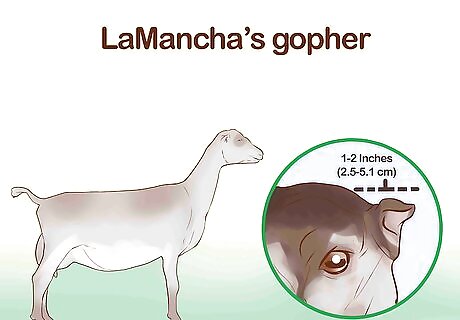
Spot a LaMancha’s gopher ears. Don’t worry if your goat has tiny ears! The LaMancha is a dairy breed with ears from 1 to 2 inches (2.5 to 5.1 cm) in length, sometimes referred to as “elf ears.” Like many other dairy breeds, they have a sturdy built, short coat that’s fine and glossy, and straight face, but their ears are their defining characteristic. Breeders and goat organization call them gopher ears because of their tiny size.
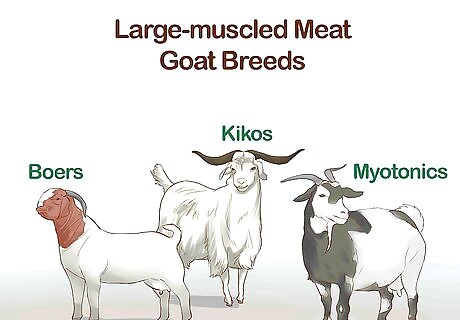
Identify large-muscled meat goat breeds. Meat goats have large legs, dense builds, and usually have horns and short coats. Unlike dairy breeds, does of meat breeds have compact udders. Common meat breeds include: Boers, which are thick, sturdy goats with horns and medium-length, hanging ears. They are heavy, meat-producing goats weighing anywhere from 200-350 lbs (90-159 kg). Their short coats can be red-brown, black, or white. Usually, Boers with white coats have red-brown or black heads. Like Boers, Kikos are well-built and alert. They have broad, straight muzzles, spiraled horns, and medium-length ears that aren’t as erect as a Swiss breed, but don’t hang like a Nubian. They can have short or thick coats and, while often white, they can come in a variety of colors. Myotonics are better known as fainting goats and are distinguished by their well-known fight or flight response. Most are black and white but multicolored goats are not uncommon.When startled, they often freeze up and fall to the ground. They’re bred as meat goats and often kept as pets, as they are easy to keep, feed, and are good milkers as well

Look for fiber goats’ luxurious coats. Mohair fiber goats are easy to identify, since they have long, crimped coats. Other fiber goats are dual coated, and have dense, downy undercoats that are used to produce cashmere. They tend to be smaller than the meat and dairy goats, weighing in at around 75-150 lbs (34-68 kg) Angoras are among the most popular fiber breeds and are easy to spot. They’re fairly large, and their long mohair fleece is always white. Pygoras and Nigoras are Angora cross-breeds also raised for mohair fiber production. Mixing breeds creates new fiber colors and results in smaller, more manageable goats. Cashmere goats are a group of several dozen breeds with downy undercoats. They come in a variety of colors, but are all cooler climate goats raised to produce the luxury fabric cashmere.
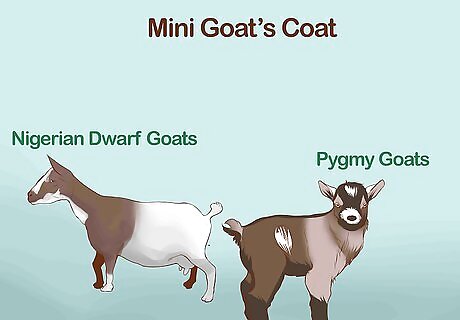
Check the length of your mini goat’s coat. Often considered multi-use breeds, miniature goats can be bred for dairy, meat, fiber, or kept as pets. The easiest way to tell between the most common breeds is to check the coat length. Nigerian Dwarf goats have the build of a dairy breed at a smaller scale, and have shorter coats. Pygmy goats are more muscular and have thick, medium to long coats.
Trying Other Resources

Ask a breeder for registration records before purchasing a goat. From disease prevention to identifying a goat’s breed and purpose, registration records are vital. While laws vary by location, most jurisdictions require goats to be tagged and registered before they’re sold. A complete registration record should indicate the goat’s gender, breed, flock number, date (or year) of birth, and information about its parents.
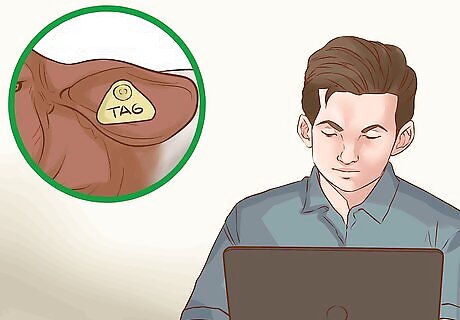
Look for breed information on tattoos, tags, and microchips. Breed associations and individual nations have distinct letter or number codes. If you’re not sure what your goat’s registration marks mean, look them up online to decode them. Start by checking your nation’s departments of agriculture, environment, or rural affairs. Tattoos are often located in a goat’s ear. Hold a flashlight to the outside of the ear so you can read the tattoo more easily. Many local 4H and agricultural clubs will be able to help you identify your goat and register it properly.

Get help from a university’s agriculture program if you’re stumped. If you have trouble identifying your goat’s breed on your own, look for a local university with agriculture or husbandry program. Try getting in touch with the department and ask if they can help you identify your breed.
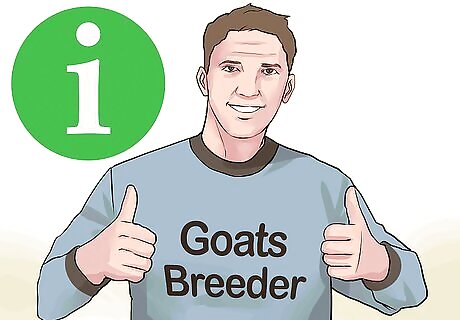
Ask local breeders for help. Once you've narrowed your goat down to a few possible breeds, try looking for local breeders who specialize in those breeds. You could ask them for help or to see their goats in person to get a better idea of how a breed looks and behaves. For example, if your doe has erect ears and a large udder, you might have a Swiss breed or another kind of dairy goat. You could check the website of your national dairy goat association for links to specific breed organizations and breeder directories.


















Comments
0 comment